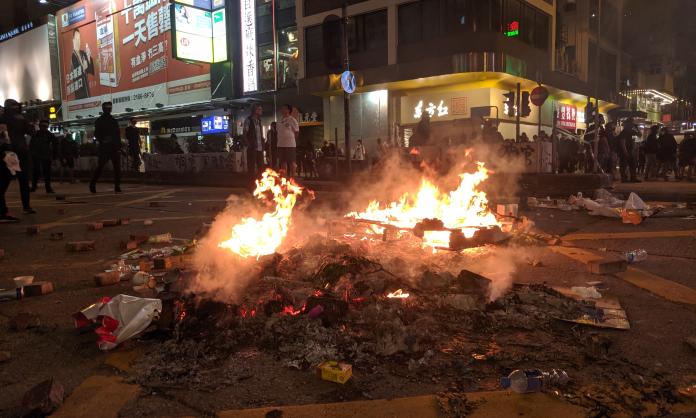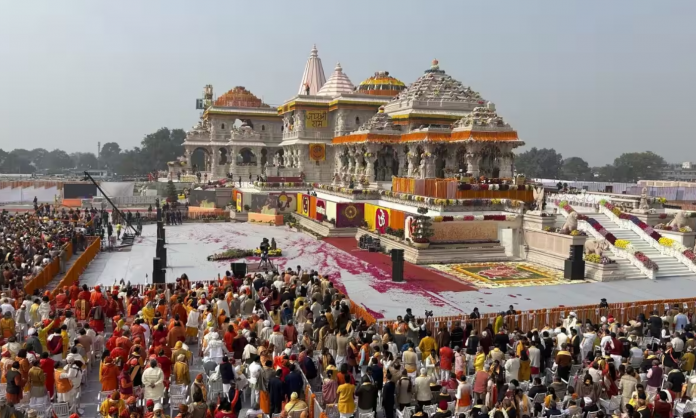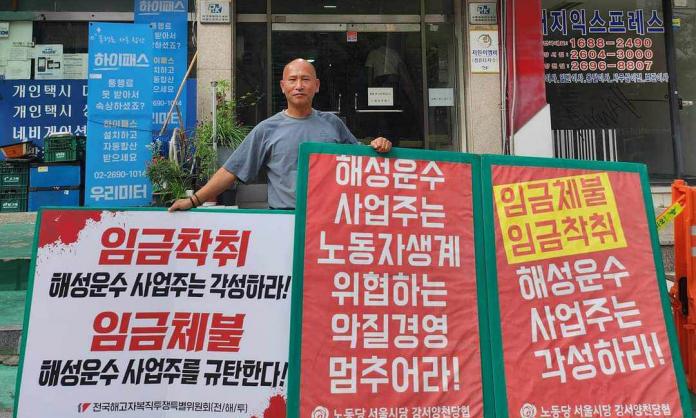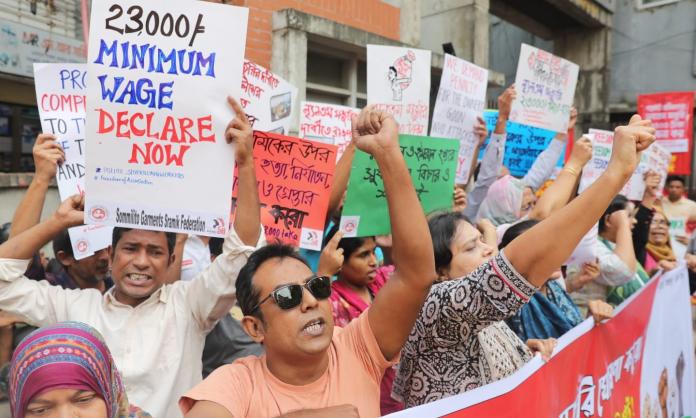Barricades and fires are everywhere along Nathan Road and in adjacent streets in Mong Kok, Hong Kong. Masked students are digging up bricks from the footpath, smashing them and littering the place to stop vehicles getting through. Others smash shop fronts, CCTV cameras and traffic lights. The signal boxes are being torn open and set ablaze, before exploding.
“Every night there is something. Tonight the scale is bigger”, a young protester tells me. “Police are attacking the university tonight – so we fight here to spread their manpower thin. When we had the peaceful demonstrations in the day, the government would shut down the trains and then the cops would stop and search the buses, taking people away to the police station. Now we are getting smarter; we are learning from our mistakes. Now we fight in our neighbourhoods. We fight everywhere.”
Thirty districts have been shaken by protests. The South China Morning Post reports that yesterday almost 300 people were arrested. One was shot with a live round. Two hundred and fifty-five canisters of tear gas, 204 rubber bullets, 45 beanbag rounds and 96 sponge grenades were also fired. Protesters say that organised crime groups are being used as hired thugs as well.
It’s Tuesday. At the Chinese University across town, police are again firing rubber bullets and trying to take the campus. But word has it that they are facing stiff resistance. The police have shut the eastern metro line to isolate the campus only to trigger absolute carnage in this part of town. Busloads of riot police move in, firing volley after volley of tear gas. The protesters blow whistles and disperse. “Be like water”, they say. The cops advance several hundred metres south along Nathan, firing teargas in all directions. A water cannon hits a few people who stayed too close. For a time, it seems as though police have secured the road.
Wrong.
When they move back toward their HQ, bricks fly from a side street at their vehicles. The students have doubled back, almost in a pincer move. It felt like there were hundreds. But now they are swarming everywhere. There are thousands of them. Busting into construction sites, they dismantle scaffolding and use it to reinforce the barricades. They grab anything they can get their hands on – long bars of reinforced steel, bags of rubbish, bamboo poles, plastic wrapping – then spray the whole thing with whatever sticky or gluey substance they can find. The sidewalk is being torn apart and brick after brick is thrown onto the roads.
“CCP [Chinese Communist Party] and the government have the power to stop this”, a young woman says. “There should be universal suffrage so we can choose for ourselves how to live.” This is one of the key issues at stake. Hong Kong’s Basic Law (a mini constitution), drawn up before the territory was reincorporated into Chinese sovereignty in 1997 following more than 100 years of British colonial administration, noted universal suffrage as an “ultimate aim”. However, growing hostility to CCP authoritarianism and intolerable economic conditions means fewer and fewer people in Hong Kong identify as Chinese.
In 2014, the Chinese government clarified that giving everyone the vote is definitely the aim. But candidates for chief executive must be “patriots” – “a person who loves the country [China]” – chosen by a nominating committee chosen by the government. And while Hong Kongers continue to have more rights than mainlanders under the Basic Law, the territory will be fully incorporated no later than 2047. They don’t like this one bit.
Protesters yell at the cops constantly. What are they saying? Murderers! “We want to piss them off, make them angry”, another protester says. “We have to engage them. Keep them here. We have to save the university.” To the side, a dozen stand and squat, holding open umbrellas to conceal themselves. They’re making Molotov cocktails. Another group, using the same method of concealment, are trying to break through a bank roller shutter. It’s impossible to make out the politics of the hardcore blocs (within the broader protest, there are at least a dozen different groups ranging in size from six to 20 participants). Graffiti everywhere – literally everywhere – attacks “the PoPo” (police). There’s also “freedom or death”, “we are the future”, “Catalunya independence”, and a riff on Che Guevara’s famous quote: “Injustice (CCP China) anywhere is a threat to justice everywhere”. Some carry metal bars and hammers to smash anything and everything.
“Where am I, Syria?!”, an older man says, visibly shaking as he points to the attempted bank break-in. He doesn’t support the students? “I support the students, of course! All the violence is from the police. This was inevitable. The police take their orders from China. The government takes its orders from China. To me [Hong Kong chief executive] Carrie Lam is the devil woman. To go to hell 10 times is not enough!”
No-one has a megaphone. The protesters rely on collective mustering, shouts starting at one position and filtering down to give directions, make appeals or warn of police movements. It is a constant back and forth. Cops move forward, fire tear gas. Protesters retreat, then move forward again. Just after midnight, a human chain about 200 metres long forms along Nathan Road. They pass umbrellas and bottles to the front. The Molotov operation is quite collective.
Some shine lasers and high-powered torches on figures at the top of a nearby building. It’s the district police station and the commander is on the roof, surveying the situation. The cops have left the street and fortified their position in the building. The complex’s loudspeaker airs repeated calls to disperse. But the front line umbrella group advances anyway, only to be belted with tear gas. While many protesters have gas masks, most don’t. They retreat. But as soon as the gas clears, people push forward again. Several dozen police storm out, firing yet more gas. Another retreat, followed by another advance. It is unrelenting and goes on for hours.
The cops fire rubber bullets. One student is hit in the leg. A bullet glances off another’s jaw. They are rushed to a side street by the student medics. But no-one will let up. The umbrella group again moves forward, throwing Molotovs. One is dropped by a rubber bullet to the leg. Another’s little finger is left gashed. Calls ring out left and right for the medics, who race to every call.
A middle-aged man in a suit jacket walks through the crowd handing out umbrellas. “There’re not from me, they’re from my neighbour – I live here. She is old and didn’t want to come down. But she wanted to help.” Another man walks around with a shopping bag full of small tissue packets. After 1am, the cops come out in force again. Bricks and Molotovs fly in retaliation, but now they are just gestures. Everyone has been driven back and into the side streets by a barrage of tear gas cannisters. The air is thick with it and smoke from everything else burning. In the middle of it all, an old street stall vendor continues selling away. He’s nonchalantly sitting there in a gas mask doing a vigorous trade in drinks, completely unperturbed.
Police progress several blocks and there is a lull. When they retreat at about 2:30, the protest has diminished in size. Again the students move forward and reassemble the damaged barricades. It will be on again tomorrow.










